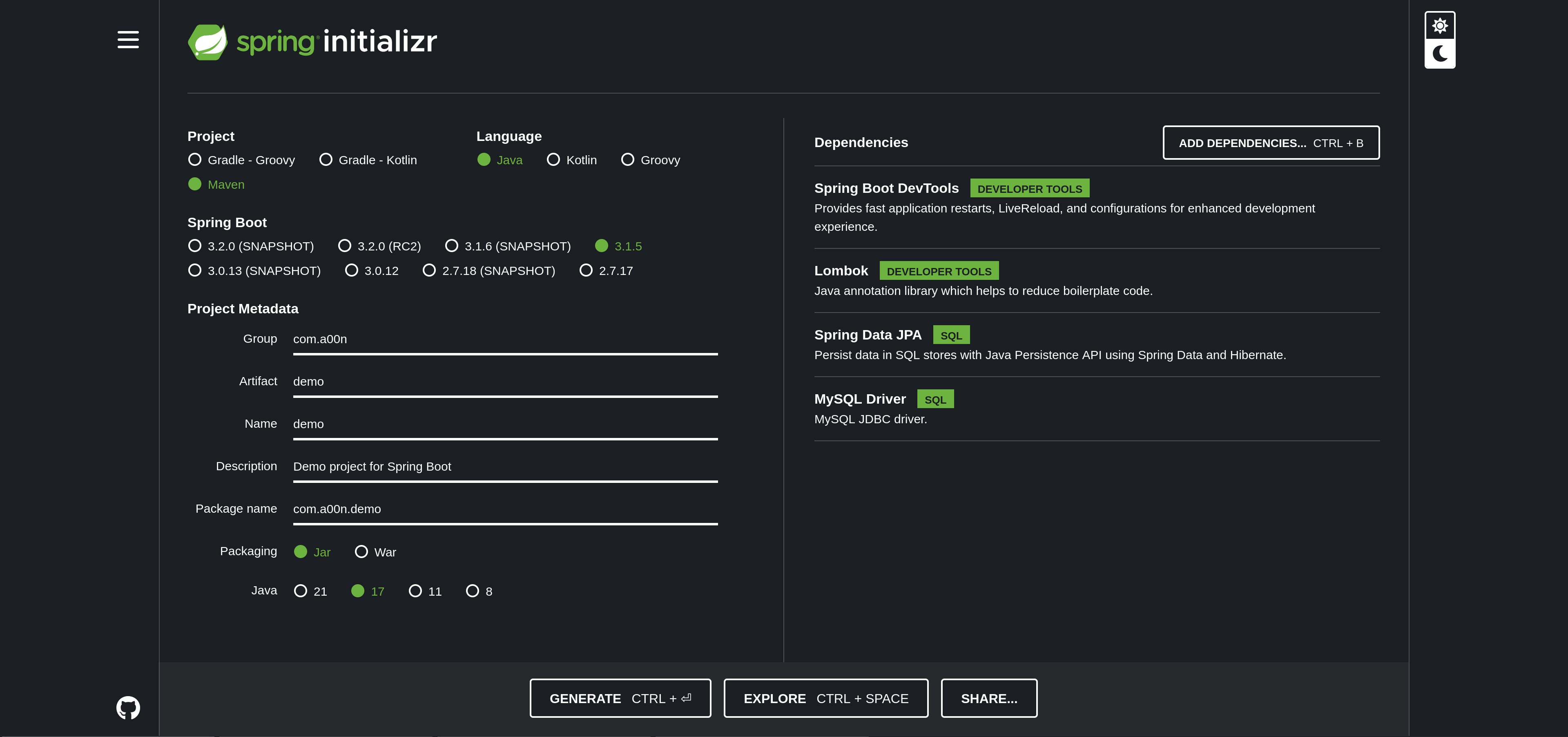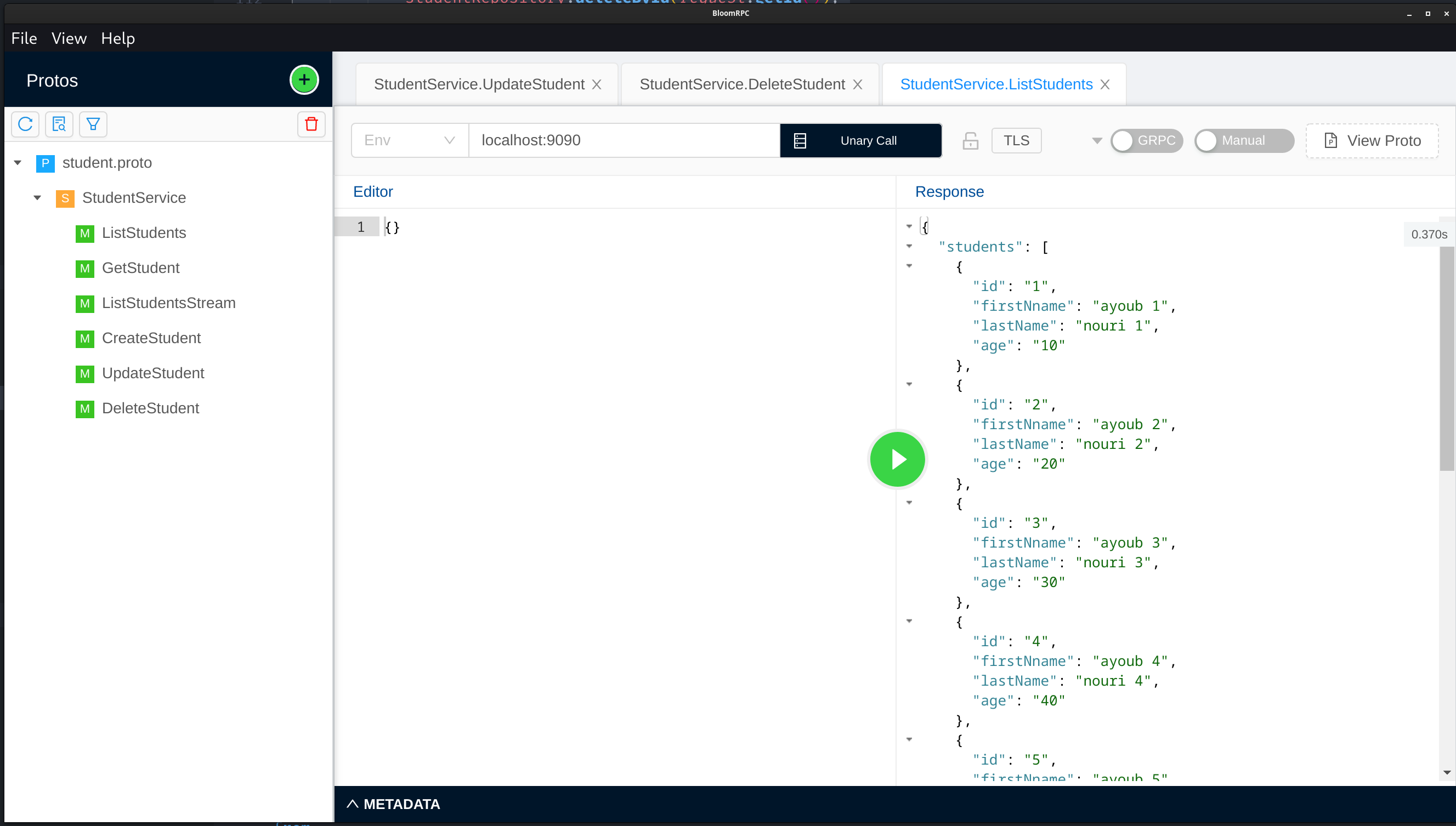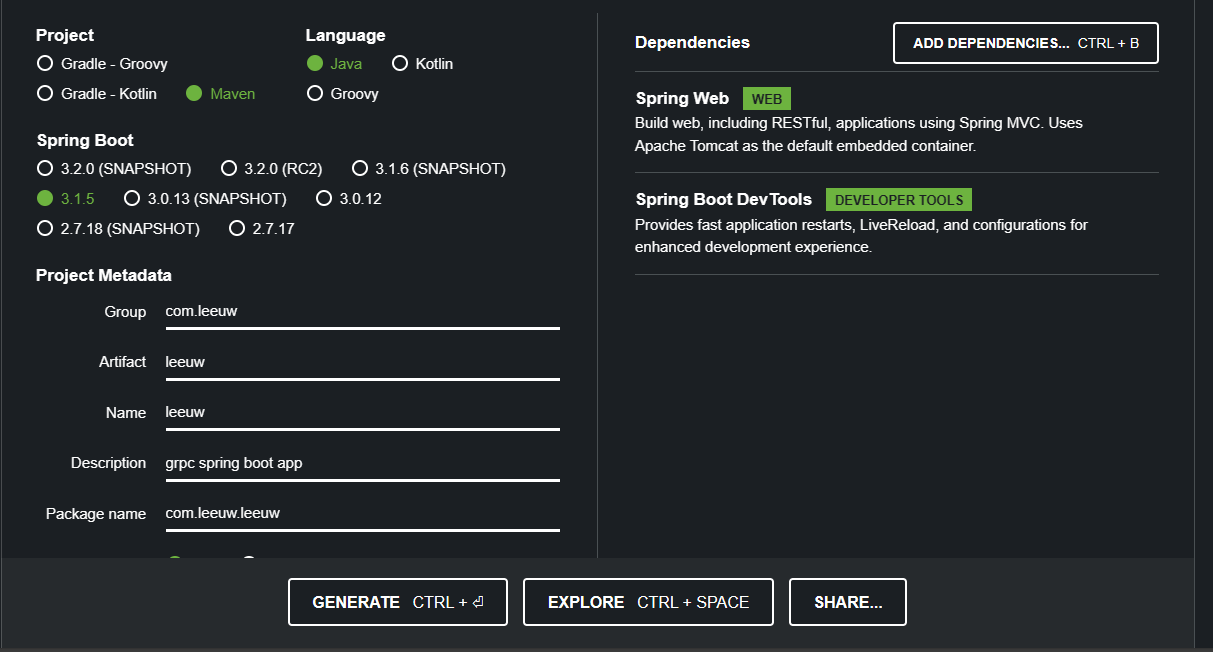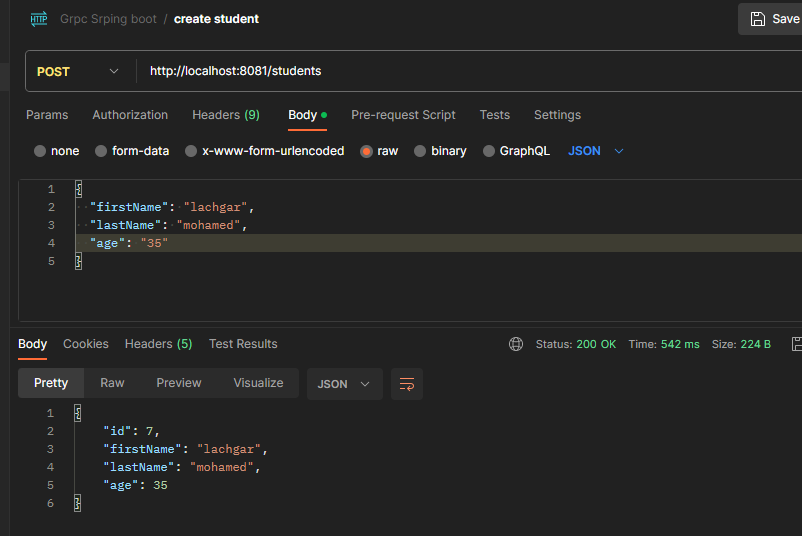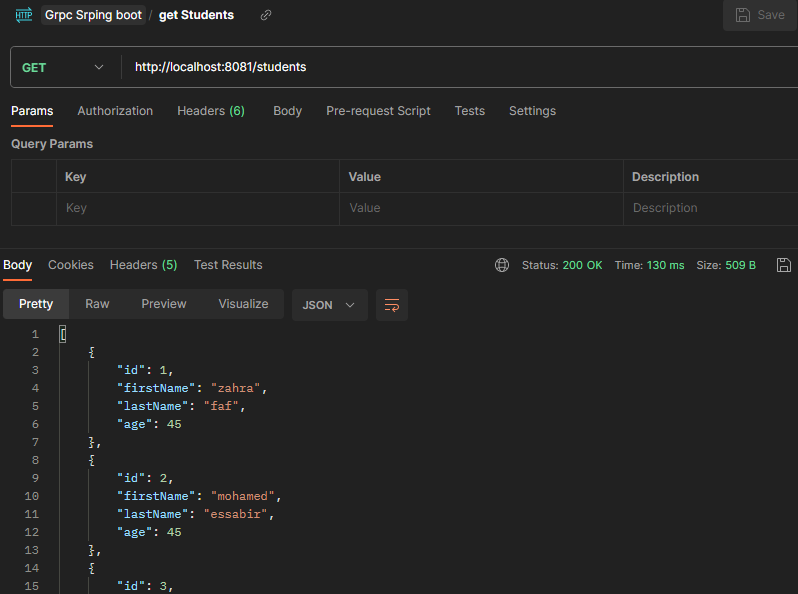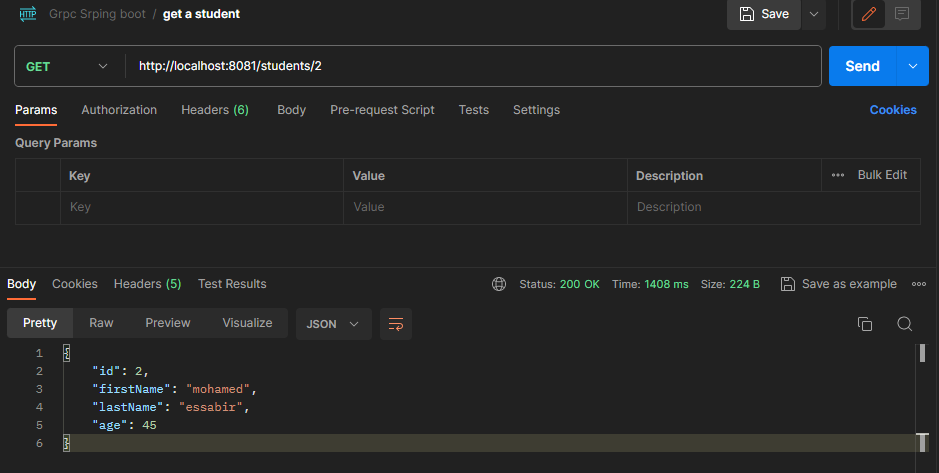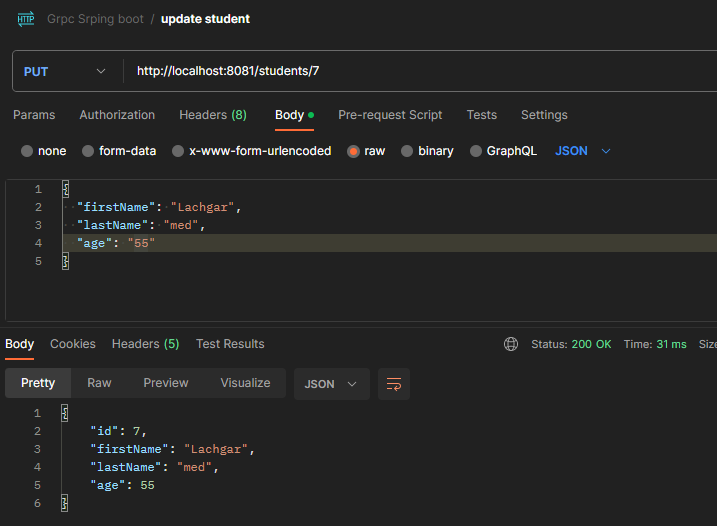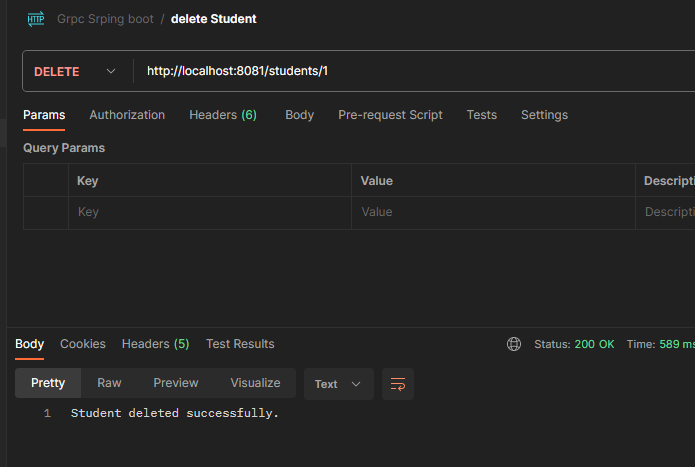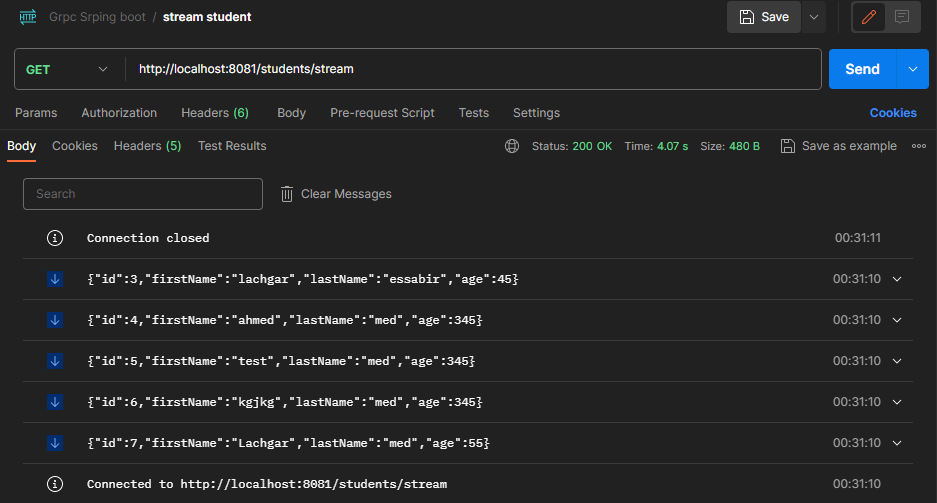In this project, we will focus on the client-side implementation of a gRPC Spring Boot application. Our primary goal is to facilitate CRUD (Create, Read, Update, Delete) operations for managing student records. This involves functionalities such as adding new students, deleting existing records, updating student information, and efficiently retrieving and displaying a list of students using React programming and streams. We will also leverage React programming to efficiently retrieve and display a list of students using streams.
Follow these steps to set up the server:
Use spring initializr (or anything you want) and create a simple spring boot project
Include the following properties within your configuration:
<protobuf.version>3.23.4</protobuf.version>
<protobuf-plugin.version>0.6.1</protobuf-plugin.version>
<grpc.version>1.58.0</grpc.version>Adding the following dependencies:
<dependency>
<groupId>io.grpc</groupId>
<artifactId>grpc-stub</artifactId>
<version>${grpc.version}</version>
</dependency>
<dependency>
<groupId>io.grpc</groupId>
<artifactId>grpc-protobuf</artifactId>
<version>${grpc.version}</version>
</dependency>
<dependency>
<groupId>jakarta.annotation</groupId>
<artifactId>jakarta.annotation-api</artifactId>
<version>1.3.5</version>
<optional>true</optional>
</dependency>
<dependency>
<groupId>net.devh</groupId>
<artifactId>grpc-spring-boot-starter</artifactId>
<version>2.15.0.RELEASE</version>
</dependency>Add the following plugin:
<plugin>
<groupId>com.github.os72</groupId>
<artifactId>protoc-jar-maven-plugin</artifactId>
<version>3.11.4</version>
<executions>
<execution>
<phase>generate-sources</phase>
<goals>
<goal>run</goal>
</goals>
<configuration>
<includeMavenTypes>direct</includeMavenTypes>
<inputDirectories>
<include>src/main/resources</include>
</inputDirectories>
<outputTargets>
<outputTarget>
<type>java</type>
<outputDirectory>src/main/java</outputDirectory>
</outputTarget>
<outputTarget>
<type>grpc-java</type>
<pluginArtifact>io.grpc:protoc-gen-grpc-java:1.15.0</pluginArtifact>
<outputDirectory>src/main/java</outputDirectory>
</outputTarget>
</outputTargets>
</configuration>
</execution>
</executions>
</plugin>Place your protobuf definitions / .proto files in src/main/resources. For writing protobuf files please refer to the official protobuf docs.
Your .proto files will look similar to the example below:
syntax = "proto3";
option java_package = "com.a00n.grpc.stubs"; // replace this with your_package_name_gprc.stubs
message Student {
int64 id = 1;
string firstName = 2;
string lastName = 3;
int64 age = 4;
}
message Empty {}
service StudentService {
rpc ListStudents(Empty) returns (ListStudentsResponse);
rpc GetStudent(GetStudentRequest) returns (Student);
rpc CreateStudent(CreateStudentRequest) returns (Student);
rpc UpdateStudent(Student) returns (Student);
rpc DeleteStudent(DeleteStudentRequest) returns (DeleteStudentResponse);
}
message ListStudentsResponse { repeated Student students = 1; }
message GetStudentRequest { int64 id = 1; }
message DeleteStudentRequest { int64 id = 1; }
message DeleteStudentResponse { string message = 1; }
message CreateStudentRequest {
string firstName = 1;
string lastName = 2;
int64 age = 3;
}-
run
mvn clean install -
Please observe that the package
grpc.studshas been generated. Inside this package, you should find two Java files:StudentOutClassandStudentServiceGrpc
First let's create our jpa entity :
import jakarta.persistence.Entity;
import jakarta.persistence.GeneratedValue;
import jakarta.persistence.GenerationType;
import jakarta.persistence.Id;
import lombok.AllArgsConstructor;
import lombok.Builder;
import lombok.Data;
import lombok.NoArgsConstructor;
@Entity
@Data
@Builder
@AllArgsConstructor
@NoArgsConstructor
public class Student {
@Id
@GeneratedValue(strategy = GenerationType.IDENTITY)
private Long id;
private String firstName;
private String lastName;
private Long age;
}also as always you should create the repositories :
@Repository
public interface StudentRepository extends JpaRepository<Student, Long> {
}Now let's create a class that will map objects of Grpc student class to objects of jpa student class :
@Component
public class StudentMapper {
public com.a00n.grpc.stubs.StudentOuterClass.Student toGrpcStudent(Student student) {
return com.a00n.grpc.stubs.StudentOuterClass.Student.newBuilder().setId(student.getId())
.setFirstName(student.getFirstName())
.setLastName(student.getLastName())
.setAge(student.getAge())
.build();
}
public Student fromGrpcStudent(com.a00n.grpc.stubs.StudentOuterClass.Student student) {
return new Student(student.getId(), student.getFirstName(), student.getLastName(), student.getAge());
}
}The protoc-jar-maven-plugin plugin generates a class for each of your grpc services. For example: MyServiceGrpc where MyService is the name of the grpc service in the proto file. This class contains both the client stubs and the server ImplBase that you will need to extend.
After that you have only four tasks to do:
- Make sure that your
MyServiceImplextendsMyServiceGrpc.MyServiceImplBase - Add the
@GrpcServiceannotation to yourMyServiceImplclass - Make sure that the
MyServiceImplis added to your application context,- either by creating
@Beandefinition in one of your@Configurationclasses - or placing it in spring’s automatically detected paths (e.g. in the same or a sub package of your
Mainclass)
- either by creating
- Actually implement the grpc service methods.
Your grpc service class will then look somewhat similar to the example below:
@GrpcService
@RequiredArgsConstructor
public class GrpcStudentServiceIml extends StudentServiceGrpc.StudentServiceImplBase {
private final StudentRepository studentRepository;
private final StudentMapper studentMapper;
@Override
public void listStudents(Empty request, StreamObserver<ListStudentsResponse> responseObserver) {
List<Student> students = studentRepository.findAll();
List<StudentOuterClass.Student> listStudents = students.stream()
.map(studentMapper::toGrpcStudent)
.toList();
ListStudentsResponse listStudentsResponse = ListStudentsResponse.newBuilder()
.addAllStudents(listStudents)
.build();
responseObserver.onNext(listStudentsResponse);
responseObserver.onCompleted();
}
@Override
public void listStudentsStream(Empty request,
StreamObserver<StudentOuterClass.Student> responseObserver) {
List<Student> students = studentRepository.findAll();
List<StudentOuterClass.Student> listStudents = students.stream()
.map(studentMapper::toGrpcStudent)
.toList();
if (listStudents.isEmpty()) {
responseObserver.onError(Status.INTERNAL.withDescription("no student found").asException());
} else {
Stack<StudentOuterClass.Student> stackStudents = new Stack<>();
stackStudents.addAll(listStudents);
Timer timer = new Timer("students timer");
timer.schedule(new TimerTask() {
@Override
public void run() {
responseObserver.onNext(stackStudents.pop());
if (stackStudents.isEmpty()) {
responseObserver.onCompleted();
timer.cancel();
}
}
}, 0, 1000);
}
}
@Override
public void getStudent(GetStudentRequest request,
StreamObserver<StudentOuterClass.Student> responseObserver) {
Student student = studentRepository.findById(request.getId()).orElse(null);
if (student == null) {
responseObserver.onError(Status.INTERNAL.withDescription("student not found").asException());
} else {
responseObserver.onNext(studentMapper.toGrpcStudent(student));
responseObserver.onCompleted();
}
}
@Override
public void createStudent(CreateStudentRequest request,
StreamObserver<StudentOuterClass.Student> responseObserver) {
Student student = Student.builder().firstName(request.getFirstName()).lastName(request.getLastName()).age(request.getAge()).build();
responseObserver.onNext(studentMapper.toGrpcStudent(studentRepository.save(student)));
responseObserver.onCompleted();
}
@Override
public void updateStudent(StudentOuterClass.Student request,
StreamObserver<StudentOuterClass.Student> responseObserver) {
if (studentRepository.existsById(request.getId())) {
Student student = studentRepository.save(studentMapper.fromGrpcStudent(request));
responseObserver.onNext(studentMapper.toGrpcStudent(student));
responseObserver.onCompleted();
} else {
responseObserver.onError(Status.INTERNAL.withDescription("student not found").asException());
}
}
@Override
public void deleteStudent(DeleteStudentRequest request,
StreamObserver<DeleteStudentResponse> responseObserver) {
if (studentRepository.existsById(request.getId())) {
studentRepository.deleteById(request.getId());
DeleteStudentResponse deleteStudentResponse = DeleteStudentResponse.newBuilder()
.setMessage("Student Deleted").build();
responseObserver.onNext(deleteStudentResponse);
responseObserver.onCompleted();
} else {
responseObserver.onError(Status.INTERNAL.withDescription("student not found").asException());
}
}
}Add the following propeties to application.properties
spring.datasource.url=jdbc:mysql://localhost:3306/grpc_student?createDatabaseIfNotExist=true
spring.jpa.hibernate.ddl-auto=create
spring.datasource.username=root
spring.datasource.password=
spring.datasource.driver-class-name=com.mysql.cj.jdbc.Driver
spring.jpa.show-sql=true
spring.jpa.properties.hibernate.format_sql=true
spring.jpa.properties.hibernate.highlight_sql=trueThat’s all. Now you can start your spring-boot application and start sending requests to your grpc-service.
By default, the grpc-server will be started on port 9090 using PLAINTEXT mode.
You can test that your application is working as expected by using this BloomRPC :
Follow these steps to set up the client:
Head to https://start.spring.io and generate a spring boot app
Include the following properties within your configuration:
<protobuf.version>3.23.4</protobuf.version>
<protobuf-plugin.version>0.6.1</protobuf-plugin.version>
<grpc.version>1.58.0</grpc.version>Adding the following dependencies:
<dependency>
<groupId>io.grpc</groupId>
<artifactId>grpc-stub</artifactId>
<version>${grpc.version}</version>
</dependency>
<dependency>
<groupId>io.grpc</groupId>
<artifactId>grpc-protobuf</artifactId>
<version>${grpc.version}</version>
</dependency>
<dependency>
<groupId>net.devh</groupId>
<artifactId>grpc-client-spring-boot-starter</artifactId>
<version>2.15.0.RELEASE</version>
</dependency>
<dependency>
<groupId>javax.annotation</groupId>
<artifactId>javax.annotation-api</artifactId>
<version>1.2</version>
<optional>true</optional>
</dependency>
<dependency>
<groupId>io.projectreactor</groupId>
<artifactId>reactor-core</artifactId>
<version>3.5.11</version>
</dependency>
<dependency>
<groupId>ch.qos.logback</groupId>
<artifactId>logback-classic</artifactId>
<version>1.4.11</version>
</dependency>Add the following plugin:
<plugin>
<groupId>com.github.os72</groupId>
<artifactId>protoc-jar-maven-plugin</artifactId>
<version>3.11.4</version>
<executions>
<execution>
<phase>generate-sources</phase>
<goals>
<goal>run</goal>
</goals>
<configuration>
<includeMavenTypes>direct</includeMavenTypes>
<inputDirectories>
<include>src/main/resources</include>
</inputDirectories>
<outputTargets>
<outputTarget>
<type>java</type>
<outputDirectory>src/main/java</outputDirectory>
</outputTarget>
<outputTarget>
<type>grpc-java</type>
<pluginArtifact>io.grpc:protoc-gen-grpc-java:1.15.0</pluginArtifact>
<outputDirectory>src/main/java</outputDirectory>
</outputTarget>
</outputTargets>
</configuration>
</execution>
</executions>
</plugin>-
Make sure to have the
Student.protoinside the resources folder. -
run
mvn clean install -
Please observe that the package
grpc.studshas been generated. Inside this package, you should find two Java files:StudentOutClassandStudentServiceGrpc
Create a Student dto.
public class Student {
private Long id;
private String firstName;
private String lastName;
private Long age;
public Student() {
}
public Student(String firstName, String lastName, Long age) {
this.firstName = firstName;
this.lastName = lastName;
this.age = age;
}
public Long getId() {
return this.id;
}
public void setId(Long id) {
this.id = id;
}
public String getFirstName() {
return this.firstName;
}
public void setFirstName(String firstName) {
this.firstName = firstName;
}
public String getLastName() {
return this.lastName;
}
public void setLastName(String lastName) {
this.lastName = lastName;
}
public Long getAge() {
return this.age;
}
public void setAge(Long age) {
this.age = age;
}
}Create the client Service
@Service
public class GrpcClientService {
@GrpcClient("service")
StudentServiceGrpc.StudentServiceBlockingStub studentServiceStub;
@GrpcClient("service")
StudentServiceGrpc.StudentServiceStub asyncStudentServiceStub;
public StudentOuterClass.ListStudentsResponse listStudents() {
return studentServiceStub.listStudents(StudentOuterClass.Empty.newBuilder().build());
}
public Flux<StudentOuterClass.Student> listStudentsStream() {
// Use Flux.create to handle the asynchronous nature of gRPC streaming
return Flux.create(emitter -> {
asyncStudentServiceStub.listStudentsStream(StudentOuterClass.Empty.newBuilder().build(),
new StreamObserver<StudentOuterClass.Student>() {
@Override
public void onNext(StudentOuterClass.Student student) {
// Emit each student to the Flux
emitter.next(student);
}
@Override
public void onError(Throwable throwable) {
// Signal error to the Flux
emitter.error(throwable);
}
@Override
public void onCompleted() {
// Signal completion to the Flux
emitter.complete();
}
});
}, FluxSink.OverflowStrategy.BUFFER);
}
public StudentOuterClass.Student getStudentById(long id) {
StudentOuterClass.GetStudentRequest request = StudentOuterClass.GetStudentRequest.newBuilder().setId(id).build();
return studentServiceStub.getStudent(request);
}
public StudentOuterClass.Student createStudent(String firstName, String lastName, long age) {
StudentOuterClass.CreateStudentRequest request = StudentOuterClass.CreateStudentRequest.newBuilder()
.setFirstNname(firstName)
.setLastName(lastName)
.setAge(age)
.build();
return studentServiceStub.createStudent(request);
}
public StudentOuterClass.Student updateStudent(StudentOuterClass.Student student) {
return studentServiceStub.updateStudent(student);
}
public StudentOuterClass.DeleteStudentResponse deleteStudent(long id) {
StudentOuterClass.DeleteStudentRequest request = StudentOuterClass.DeleteStudentRequest.newBuilder().setId(id).build();
return studentServiceStub.deleteStudent(request);
}
}Creating a controller name it GrpcController or what ever you want.
@RestController
@RequestMapping("/students")
public class GrpcController {
private GrpcClientService grpcStudentClient;
@Autowired
public GrpcController(GrpcClientService grpcStudentClient) {
this.grpcStudentClient = grpcStudentClient;
}
@GetMapping
public ResponseEntity<List<Student>> getStudentList() {
try {
// Call gRPC service to get a list of students
StudentOuterClass.ListStudentsResponse studentList = grpcStudentClient.listStudents();
// Convert gRPC response to DTOs
List<Student> responseList = new ArrayList<>();
for (StudentOuterClass.Student student : studentList.getStudentsList()) {
Student studentDTO = new Student();
studentDTO.setId(student.getId());
studentDTO.setFirstName(student.getFirstNname());
studentDTO.setLastName(student.getLastName());
studentDTO.setAge(student.getAge());
responseList.add(studentDTO);
}
return ResponseEntity.ok(responseList);
} catch (Exception e) {
// Handle the exception, you can log it or return a specific error response
return ResponseEntity.status(HttpStatus.INTERNAL_SERVER_ERROR).body(null);
}
}
@GetMapping(value = "/{id}")
public ResponseEntity<Student> getStudentById(@PathVariable Long id) {
try{
StudentOuterClass.Student student = grpcStudentClient.getStudentById(id);
// Convert gRPC response to DTO
Student createdStudentDTO = new Student();
createdStudentDTO.setId(student.getId());
createdStudentDTO.setFirstName(student.getFirstNname());
createdStudentDTO.setLastName(student.getLastName());
createdStudentDTO.setAge(student.getAge());
return ResponseEntity.ok(createdStudentDTO);
}catch (Exception e){
return ResponseEntity.status(HttpStatus.NOT_FOUND).body(null);
}
}
@GetMapping(value = "/stream", produces = MediaType.TEXT_EVENT_STREAM_VALUE)
public Flux<Student> streamStudents() {
return Flux.fromStream(grpcStudentClient.listStudentsStream().toStream())
.map(student -> {
Student studentDTO = new Student();
studentDTO.setId(student.getId());
studentDTO.setFirstName(student.getFirstNname());
studentDTO.setLastName(student.getLastName());
studentDTO.setAge(student.getAge());
return studentDTO;
});
}
@PostMapping
public ResponseEntity<Student> createStudent(@RequestBody Student request) {
String firstName = request.getFirstName();
String lastName = request.getLastName();
long age = request.getAge();
System.out.println(firstName);
StudentOuterClass.Student createdStudent = grpcStudentClient.createStudent(firstName, lastName, age);
// Convert gRPC response to DTO
Student createdStudentDTO = new Student();
createdStudentDTO.setId(createdStudent.getId());
createdStudentDTO.setFirstName(createdStudent.getFirstNname());
createdStudentDTO.setLastName(createdStudent.getLastName());
createdStudentDTO.setAge(createdStudent.getAge());
return ResponseEntity.ok(createdStudentDTO);
}
@PutMapping("/{id}")
public ResponseEntity<Student> updateStudent(@PathVariable Long id, @RequestBody Student updatedStudentDTO) {
StudentOuterClass.Student updatedStudent = StudentOuterClass.Student.newBuilder()
.setId(id)
.setFirstNname(updatedStudentDTO.getFirstName())
.setLastName(updatedStudentDTO.getLastName())
.setAge(updatedStudentDTO.getAge())
.build();
// Call gRPC service to update student
StudentOuterClass.Student updatedStudentResponse = grpcStudentClient.updateStudent(updatedStudent);
// Convert gRPC response to DTO
Student updatedStudentResponseDTO = new Student();
updatedStudentResponseDTO.setId(updatedStudentResponse.getId());
updatedStudentResponseDTO.setFirstName(updatedStudentResponse.getFirstNname());
updatedStudentResponseDTO.setLastName(updatedStudentResponse.getLastName());
updatedStudentResponseDTO.setAge(updatedStudentResponse.getAge());
return ResponseEntity.ok(updatedStudentResponseDTO);
}
@DeleteMapping("/{id}")
public ResponseEntity<String> deleteStudent(@PathVariable Long id) {
// Call gRPC service to delete student
StudentOuterClass.DeleteStudentResponse deleteResponse = grpcStudentClient.deleteStudent(id);
// Check if the deletion was successful
if (deleteResponse != null && "Student Deleted".equalsIgnoreCase(deleteResponse.getMessage())) {
return ResponseEntity.ok("Student deleted successfully.");
} else {
return ResponseEntity.status(HttpStatus.INTERNAL_SERVER_ERROR).body("Failed to delete student.");
}
}
}Add the following lines to application.properties
grpc.client.service.address=static://localhost:9090
grpc.client.service.negotiation-type=plaintextIn this section, we'll enhance security by implementing an additional layer to secure the communication between the client and the server.
Firstly, ensure that OpenSSL is installed on your system. For Mac or Linux users, OpenSSL is typically included by default. For Windows users, if it's not installed, you can add it using the following PowerShell command.
choco install openssl.lightGenerate CA's private key
openssl genrsa -des3 -out ca.key.pem 2048
Create CA's self-signed certificate
openssl req -x509 -new -nodes -key ca.key.pem -sha256 -days 365 -out localhost.cert.pem
Create private key for server
openssl genrsa -out localhost.key 2048
Create certificate signing request (CSR)
openssl req -new -key localhost.key -out localhost.csr
Use CA's private key to sign web server's CSR and get back the signed certificate
openssl x509 -req -in localhost.csr -CA localhost.cert.pem -CAkey ca.key.pem -CAcreateserial -out localhost.crt -days 365
Convert server private key in PKCS8 standard(gRPc expects)
openssl pkcs8 -topk8 -nocrypt -in localhost.key -out localhost.pem
Create a folder certificates outside your src directory. Copy/paste the private key localhost.pem and localhost.crt to the folder.
@GrpcGlobalServerInterceptor
public class AuthInterceptor implements ServerInterceptor {
@Override
public <ReqT, RespT> ServerCall.Listener<ReqT> interceptCall(ServerCall<ReqT, RespT> serverCall, Metadata metadata,
ServerCallHandler<ReqT, RespT> serverCallHandler) {
System.out.println("Sever interceptor " + serverCall.getMethodDescriptor());
Metadata.Key<String> apiKeyMetadata = Metadata.Key.of("grpc-api-key",
Metadata.ASCII_STRING_MARSHALLER);
String apiKey = metadata.get(apiKeyMetadata);
System.out.println("grpc-api-key from client " + apiKey);
if (Objects.nonNull(apiKey) && apiKey.equals("secret")) {
return serverCallHandler.startCall(serverCall, metadata);
} else {
Status status = Status.UNAUTHENTICATED.withDescription("Invalid api-key");
serverCall.close(status, metadata);
}
return new ServerCall.Listener<>() {
};
}
}At the end of your application.properties add these two lines
grpc.server.security.enabled=true
grpc.server.security.certificate-chain=file:certs\\localhost.crt
grpc.server.security.private-key=file:certs\\localhost.pemCreate a folder certificates outside your src directory. Copy/paste localhost.cert.pem to the folder.
@GrpcGlobalClientInterceptor
public class AuthInterceptor implements ClientInterceptor {
@Override
public <ReqT, RespT> ClientCall<ReqT, RespT> interceptCall(MethodDescriptor<ReqT, RespT> methodDescriptor,
CallOptions callOptions, Channel channel) {
System.out.println("client interceptor " + methodDescriptor.getFullMethodName());
return new ForwardingClientCall.SimpleForwardingClientCall<>(channel.newCall(methodDescriptor, callOptions)) {
@Override
public void start(Listener<RespT> responseListener, Metadata headers) {
headers.put(Metadata.Key.of("grpc-api-key", Metadata.ASCII_STRING_MARSHALLER), "secret");
super.start(responseListener, headers);
}
};
}
}At the end of your application.properties add these two lines
grpc.client.service.negotiation-type=tls
grpc.client.service.security.trust-cert-collection=file:<your_path>/localhost.cert.pem // make sure to update <your_path> with your path to the localhost.cert.pemhttps://yidongnan.github.io/grpc-spring-boot-starter/en/server/getting-started.html

